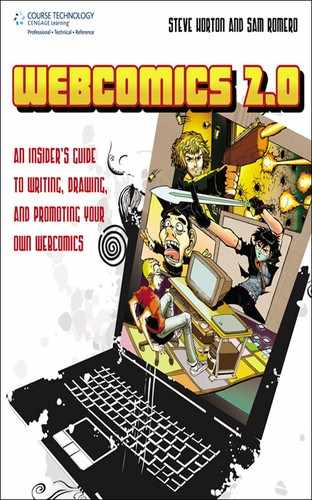Not all webcomics fit into the humor, adventure, and manga categories. There are two types of webcomics, in fact, that are gaining ground among fans—one because it offers the same dramatic soap-opera elements that keep people glued to a good TV drama, and the other because it’s totally off the wall, sometimes funny, sometimes interesting, but always bizarre.
One major type of webcomic is one that gets its roots in such printed classics as Maus and American Splendor. It’s more like real life. A soap-opera strip, in other words. Also known as slice of life, these real-life fables are sometimes autobiographical and include characters and situations that might be found in a typical episode of Friends or Grey’s Anatomy. Or, these dramatic creations mirror explorations of humanity found in the literary works of Nick Hornby or Michael Chabon, to name two.
A few slice-of-life webcomics, such as Questionable Content and Penny and Aggie(see sidebars), are staggeringly popular, as fans follow characters through their lives for years. Often, if a character dies in the course of the story, it can be devastating to the fans.
Another popular type of webcomic is the non-sequitur, or off-the-wall strip. These strips sometimes have the exact same art every day (as in Ryan North’s Dinosaur Comics at www.dinosaurcomics.com) or have art that is extremely minimalist (Nicholas Gurewitch’s Perry Bible Fellowship at www.pbfcomics.com). The point of these comics is not always to be funny, though readers laugh anyway. The point is to be weird and to do it in a way that entertains. Sometimes a non-sequitur comic will produce a quote or saying that will come to life and spread throughout the Internet. This saying can become popular enough to land on a T-shirt or be quoted in many blogs and forum posts.
Off the wall webcomics get by on the strength of their writing, especially dialogue. Since Dinosaur Comics always has the same dinosaurs, it’s the bizarre, unreal conversations between the characters that make it fun. A good TV analogy is the old Cartoon Network show Space Ghost Coast to Coast. It wasn’t always funny, but it was always weird and always entertained.
Perry Bible Fellowship has to be seen to be believed. It satirizes pop culture and kills the characters a lot. One indicator of its popularity is the print edition from Dark Horse Comics, the first volume of which has gone through several printings.
Often, the best webcomics aren’t easily pigeonholed into one genre. Successful combination of types can broaden a webcomics’ audience and expose it to more readers than one that slavishly sticks to one type. For example, Shortpacked! is ostensibly a humor comic about weird employees of a toy store. Once in awhile, creator David Willis puts in an unrelated satire comic, poking fun at an element of pop culture (often Batman, GI Joe, or Transformers) that deserves skewering. And sometimes Shortpacked! delves into drama, though it is always self-referential when this happens (characters beating each other up for having too many flashbacks, and so on).
Even the best TV dramas have comedic elements. The best sitcoms sometimes had audience-quieting drama. The webcomic Megatokyo (created by Fred Gallagher and Rodney Caston, found at www.megatokyo.com) began as a humor strip and morphed into a drama through the course of its life. If in the course of creating your webcomic you feel the actions and situations yanking the comic from one type into another, just go with it. You just might find a whole new audience waiting for you.
